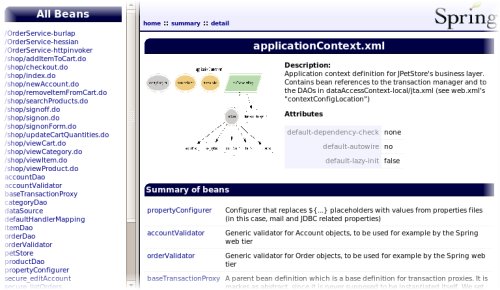
Spring BeanDoc is a tool for documenting context definition files used in Spring projects. An unmodified beandoc run produces HTML with a JavaDoc-ish look and feel to it, and graphs of the context showing dependencies, inheritance and other common constructs. However, the tool is highly configurable and extensible to meet most needs.

The tool documents a multi-file application context in a repeatable, fast way and is runnable from standard development tools such as IDE's, Ant. Maven or command shells. Re-using a standard set of properties tailored to your needs with different projects or context files is a trivial operation.
BeanDoc integrates with other open source tools where appropriate. Significant among them is the graphing package for generating the image graphs, and this will need to be downloaded and installed separately on your machine. Fortunately this is an extremely simple operation.
The simplest way to get BeanDoc up and running is by grabbing the latest binary release. Extract the file to wherever you like.
You can optionally also get source releases from there, but these should only be used as informational resources. In addition to the binary release, they contain source code and API documentation. You will not be able to build from the source tree easily using this release. See the section below on Subversion if you wish to build from source.
We strongly recommend you install GraphViz for your platform too. This is one of the most compelling aspects of using BeanDoc in the first place. Many linux distros include graphviz in their repositories, so check there first. Others may need to visit the graphviz home page to download a copy. Thanks to the ATT guys for such a great tool.
If your project uses Maven to build, you can simply add the Maven BeanDoc plugin to your pom and maven should fetch all the libs you need in order to include BeanDoc reports as part of your normal build process. See the plugin documentation for more information on how to go about this.
If you want to build beandoc from source, or you wish to get involved with the project and help out, you should obtain the code from the project's SVN repository.